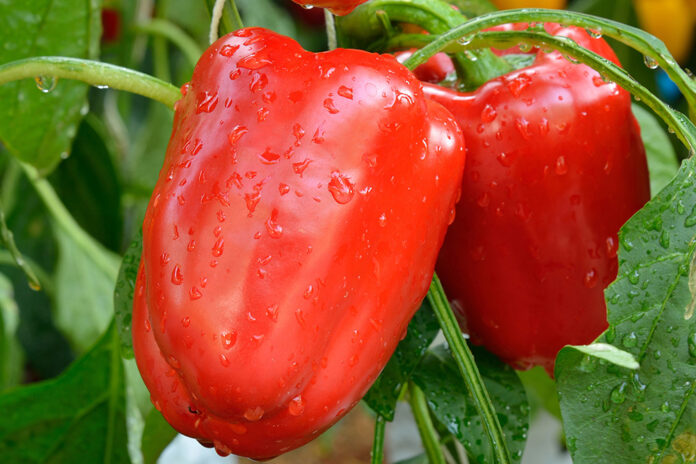By Al Brandenburg
Did you know that peppers have genders?
As an example, three-lobed bells are considered males and are best used for frying. Four-lobed bells are considered female and are best for stuffing and salads. Non-bells are all males.
That said, peppers are a breeze to grow. Basically, you plant them and watch them take off. But, for maximum production, a little pampering helps.
Plant peppers in a bed that receives full sun (at least six hours a day) and contains plenty of organic matter. Unless you want all hot peppers, keep hots and sweets well separated. Depending on the size of the pepper varieties planted, spacing should be 12-18 inches apart. Most sweet peppers mature in 60-90 days; hot peppers can take up to 150 days.
Keep in mind, however, the number of days to maturity stated on the seed packet refers to the days after transplanting until the plant produces a full-sized fruit.
Prepare the soil and plant
The right site and soil will make a world of difference in how peppers do. Choose a sunny, well-drained spot where peppers haven’t grown recently. Peppers like warmth, so wait to plant until all frost danger has passed. If possible, set out your peppers on a cloudy day to help reduce stress on the plants. Set them a bit deeper than they were in their containers.
Consider staking or caging some varieties so that the stems do not break in strong winds or because of a large fruit load. After you plant the pepper seedlings, water them well. In addition, to maintain a proper balance, before transplanting, work some organic matter into the soil to enhance moisture retention.
Feed your soil
Peppers and tomatoes are heavy feeders, so they need plenty of organic food. I suggest a balanced vegetable fertilizer such as Miracle Grow or Arizona’s Best Vegetable fertilizer. Water well after feeding.
Warning: Don’t over-fertilize. This tends to make the pepper plants develop lush foliage at the expense of fruit production. If you work 5-10-10 fertilizer into the soil prior to transplanting, that’s probably sufficient.
Water & Mulch
Throughout the growing season, make sure your pepper plants receive adequate watering. Deep watering every three to four days is better than a short water every day. Check the peppers often during periods of extreme heat and drought. The trick is to maintain adequate water without drowning a plant or drying it out.
You can use mulch to prevent excessive evaporation from the soil during the dry summer months.
Do not overwater. Peppers are thirsty plants. They need a moderate supply of water from the moment they sprout until the end of the season. However, peppers won’t tolerate a saturated soil that waterlogs their roots. The soil must drain well yet hold enough moisture to keep the plants in production.
Pinch off first flowers and use companion plants
As difficult as it might be for you (and me), pinch off any early blossoms that appear on pepper plants. This won’t harm the plants. It helps them direct their energy into growing and results in lots of large fruits later in the season instead of just a few small fruits early on. Spray Neem Oil on the underside of the leaves to help control our favorite pests, white flies. It’s claimed that growing basil next to peppers boosts their flavor and may help to repel some common garden pests. Plus, you get pesto!
Harvest
You can harvest the peppers at their immature green or purple stage, but the flavor will be sweeter if you wait for them to turn their mature color — usually red, but sometimes golden yellow or orange. Italian fryers and jalapeños are possible exceptions as many people prefer the flavor of these peppers when they are full size but still green. To harvest the peppers, cut them off with hand pruners. Pulling them off by hand can damage the plant. Now get ready to enjoy your stuffed peppers as well as sausage, onion and pepper sandwiches…. yummy!
Al Brandenburg is a Master Gardener and Maricopa resident.
This column appears in the April issue of InMaricopa.
















![Elena Trails releases home renderings An image of one of 56 elevation renderings submitted to Maricopa's planning department for the Elena Trails subdivison. The developer plans to construct 14 different floor plans, with four elevation styles per plan. [City of Maricopa]](https://www.inmaricopa.com/wp-content/uploads/2024/04/city-041724-elena-trails-rendering-100x70.jpg)

![Affordable apartments planned near ‘Restaurant Row’ A blue square highlights the area of the proposed affordable housing development and "Restaurant Row" sitting south of city hall and the Maricopa Police Department. Preliminary architectural drawings were not yet available. [City of Maricopa]](https://www.inmaricopa.com/wp-content/uploads/2024/04/041724-affordable-housing-project-restaurant-row-100x70.jpg)